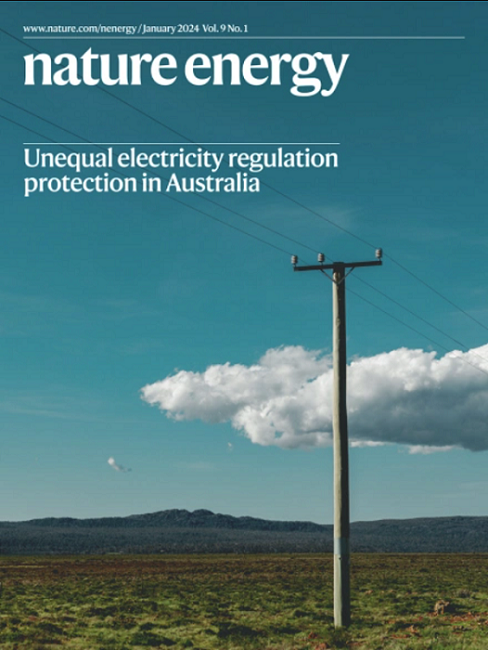采用微尺寸合金阳极的高能锂离子电池非对称电解质设计
IF 60.1
1区 材料科学
Q1 ENERGY & FUELS
引用次数: 0
摘要
在锂离子电池中,微尺寸合金阳极比石墨成本更低,容量更大。然而,它们在碳酸盐电解质中存在容量衰减快和库仑效率低的问题,这是因为有机固体电解质相(SEI)与合金紧密结合,导致 SEI 和合金颗粒出现裂缝,从而使电解质渗透,并在锂化-退锂循环过程中形成新的 SEI。使用纳米尺寸的合金阳极可以提高电池循环寿命,但同时也会缩短电池日历寿命并增加制造成本。在这里,我们通过开发非对称电解质(无溶剂离子液体和分子溶剂)来形成富含 LiF 的无机 SEI,从而大幅提高了微尺寸 Si、Al、Sn 和 Bi 阳极的循环性能,使 90 mAh μSi||LiNi0.8Mn0.1Co0.1O2 和 70 mAh Li3.75Si||SPAN 袋式电池(等容量为 4.5 mAh cm-2;N/P 为 1.4)实现了 400 次循环,容量保持率高达 85%。非对称电解质设计形成了富含锂富相间,使高容量阳极和高能量阴极实现了长循环寿命,为高能量锂离子电池提供了通用解决方案。本文章由计算机程序翻译,如有差异,请以英文原文为准。


Asymmetric electrolyte design for high-energy lithium-ion batteries with micro-sized alloying anodes
Micro-sized alloying anodes offer lower cost and higher capacity than graphite in Li-ion batteries. However, they suffer from fast capacity decay and low Coulombic efficiency in carbonate electrolytes because the organic solid electrolyte interphase (SEI) strongly bonds to the alloys, leading to cracks of both SEI and alloying particles, which allows electrolyte penetration and forms new SEI during lithiation–delithiation cycles. Using nano-sized alloying anodes can enhance the cell cycle life but also reduces the battery calendar life and increases the manufacturing costs. Here we significantly improved the cycle performance of micro-sized Si, Al, Sn and Bi anodes by developing asymmetric electrolytes (solvent-free ionic liquids and molecular solvent) to form LiF-rich inorganic SEI, enabling 90 mAh μSi||LiNi0.8Mn0.1Co0.1O2 and 70 mAh Li3.75Si||SPAN pouch cells (areal capacity of 4.5 mAh cm−2; N/P of 1.4) to achieve >400 cycles with a high capacity retention of >85%. The asymmetric electrolyte design forms LiF-rich interphases that enable high-capacity anodes and high-energy cathodes to achieve a long cycle life and provide a general solution for high-energy Li-ion batteries. Micro-sized alloying anodes in Li-ion batteries cost less and offer higher capacity than graphite but suffer from cyclability issues. Chunsheng Wang and colleagues develop asymmetric electrolytes for micro-sized Si, Al, Sn and Bi anodes using solvent-free ionic liquids and molecular solvents to tackle the issue.
求助全文
通过发布文献求助,成功后即可免费获取论文全文。
去求助
来源期刊

Nature Energy
Energy-Energy Engineering and Power Technology
CiteScore
75.10
自引率
1.10%
发文量
193
期刊介绍:
Nature Energy is a monthly, online-only journal committed to showcasing the most impactful research on energy, covering everything from its generation and distribution to the societal implications of energy technologies and policies.
With a focus on exploring all facets of the ongoing energy discourse, Nature Energy delves into topics such as energy generation, storage, distribution, management, and the societal impacts of energy technologies and policies. Emphasizing studies that push the boundaries of knowledge and contribute to the development of next-generation solutions, the journal serves as a platform for the exchange of ideas among stakeholders at the forefront of the energy sector.
Maintaining the hallmark standards of the Nature brand, Nature Energy boasts a dedicated team of professional editors, a rigorous peer-review process, meticulous copy-editing and production, rapid publication times, and editorial independence.
In addition to original research articles, Nature Energy also publishes a range of content types, including Comments, Perspectives, Reviews, News & Views, Features, and Correspondence, covering a diverse array of disciplines relevant to the field of energy.
 求助内容:
求助内容: 应助结果提醒方式:
应助结果提醒方式:


